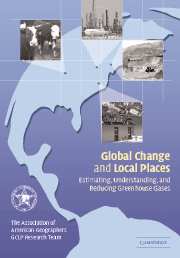Book contents
- Frontmatter
- Contents
- List of contributors
- Foreword
- Preface
- Acknowledgments
- Part One Global change and local places
- Part Two Learning from localities
- Part Three Beyond Kyoto I: greenhouse gas reduction in local places
- Part Four Beyond Kyoto II: greenhouse gas reduction potentials and strategies
- 11 Long-term potentials for reducing greenhouse gas emissions from local areas
- 12 Global change and local places: lessons learned
- Index
- References
11 - Long-term potentials for reducing greenhouse gas emissions from local areas
Published online by Cambridge University Press: 31 July 2009
- Frontmatter
- Contents
- List of contributors
- Foreword
- Preface
- Acknowledgments
- Part One Global change and local places
- Part Two Learning from localities
- Part Three Beyond Kyoto I: greenhouse gas reduction in local places
- Part Four Beyond Kyoto II: greenhouse gas reduction potentials and strategies
- 11 Long-term potentials for reducing greenhouse gas emissions from local areas
- 12 Global change and local places: lessons learned
- Index
- References
Summary
Focusing on local actions to reduce greenhouse gas emissions becomes increasingly rewarding when the analysis extends beyond current attitudes and actions toward the long term. This chapter looks out to the year 2020, with attention to the intermediate Kyoto Protocol time frame of 2010 as well. Considering the possibility that a consensus will emerge in the United States that greenhouse gas emissions should be reduced, project investigators asked how local knowledge and action could make those reductions more probable and less painful.
Global and national perspectives on long-term potentials
The Global Change and Local Places project originated in the early 1990s amid growing concerns about the likelihood of global climate change, disruptive long-range impacts of climate change, and the resulting needs to reduce anthropogenic greenhouse gas emissions and to stop degrading greenhouse gas sinks. As the project proceeded, so also did major analyses of these issues at the global and national scales, providing a backdrop for the Global Change and Local Places results as well as a basis for comparing the project's local-scale perspectives with findings from analyses at grander scales.
How much greenhouse gas emission reduction is needed?
Although it is not the only greenhouse gas, carbon dioxide concentrations are commonly used as indicators for greenhouse gas concentrations more generally. In 2000, carbon dioxide constituted about 370 parts per million (ppm) of the Earth's atmosphere. Some warming and associated physical and biological impacts were already evident.
- Type
- Chapter
- Information
- Global Change and Local PlacesEstimating, Understanding, and Reducing Greenhouse Gases, pp. 217 - 238Publisher: Cambridge University PressPrint publication year: 2003



